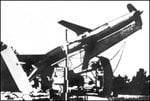A
Anonymous
Guest
Delcyros,
If the German's could have built a working "approximation fuse", they'd not have needed a fancy missile to defend Berlin. The lack of a proximimity fuse was probably the biggest single technical failure of the German's during WWII.
Why would you then assume they'd have one for this weapon?
=S=
Lunatic
If the German's could have built a working "approximation fuse", they'd not have needed a fancy missile to defend Berlin. The lack of a proximimity fuse was probably the biggest single technical failure of the German's during WWII.
Why would you then assume they'd have one for this weapon?
=S=
Lunatic










